Chapter 18-Rape and Sexual Assault
This book has been updated. The new version of this chapter is located at FreeSociologyBooks.com
Rape is not the same as sex
Rape is violence, motivated by men with power, anger, selfish, and sadistic issues. Rape is dangerous and destructive and more likely to happen in the United States than in most other countries of the world. There are 195 countries in the world today. The US typically is among the worst in terms of rape (yes, that means that most of the world's countries are safer for women than the US). Consecutive studies performed by the United Nations Surveys on crime Trends and the Operations of Criminal Justice Systems confirm that South Africa is the most dangerous, crime-ridden nation on the planet in all crimes including rape (see http://www.unodc.org/unodc/en/data-and-analysis/United-Nations-Surveys-on-Crime-Trends-and-the-Operations-of-Criminal-Justice-Systems.html).
The FBI typically keeps statistics on violent crimes committed and reported to local police (unreported crimes cannot be counted in the FBI Uniform Crime Reports). It summarizes all the local and state crimes into reports made available on various government Websites. From these data, the Bureau of Justice Statistics provides specific rape rates per 100,000 for the years 1960 to 2006 (See Figure 1 below). Alaska is by far the most dangerous state as far as rape rates are concerned.
Figure 1: Reported Rapes per 100,000 Population in United States, Alaska (Worst State Rate), and West Virginia (Safest State Rate), Years 1960-2006
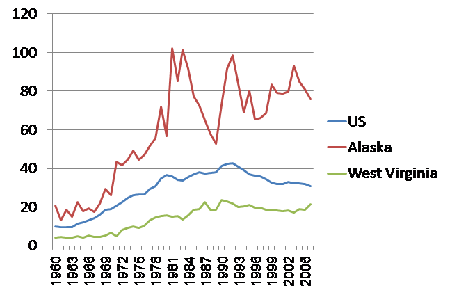
Retrieved on 13 June, 2008 From http://bjsdata.ojp.usdoj.gov/dataonline/Search/Crime/State/StatebyState.cfm
West Virginia is an example of one of the safest states. The United states in general (being in the worst 5 percent of all the world's countries) has seen a slight decline in rape rates since the early 1990s, but the danger and risks to the average woman is unacceptably too high. It is estimated that 1 in 6 US women will be sexually assaulted in their lifetimes and college-aged women are 4 times more likely to be sexually assaulted than other US women (see http://www.rainn.org/statistics ). The Rape Abuse & Incest National Network, an online Web page and the largest US's anti-sexual assault organization provides tremendous insight into rape. They also provide support for those impacted by rape (1-800-656-HOPE and an online hotline at http://www.rainn.org ). Their definition of rape and sexual assault is so concise that the US Office on Violence against Women quotes them:
Sexual assault can be defined as any type of sexual contact or behavior that occurs without the explicit consent of the recipient of the unwanted sexual activity. Falling under the definition of sexual assault is sexual activity such as forced sexual intercourse, sodomy, child molestation, incest, fondling, and attempted rape. Some more specific examples of sexual assault include:
- Unwanted vaginal, anal, or oral penetration with any object
- Forcing an individual to perform or receive oral sex
- Forcing an individual to masturbate, or to masturbate someone else
- Forcing an individual to look at sexually explicit material pose for sexually explicit pictures
- Touching, fondling, kissing, and any other unwanted sexual contact with an individual's body
- Exposure and/or flashing of sexual body parts
In general, state law assumes that a person does not consent to sexual activity if he or she is forced, threatened, unconscious, drugged, a minor, developmentally disabled, chronically mentally ill, or believe they are undergoing a medical procedure.
Perpetrators of sexual assault can be strangers, friends, acquaintances, or family members. Often, perpetrators commit sexual assault by way of violence, threats, coercion, manipulation, pressure, or tricks. In extreme cases, sexual assault may involve the use of force which may include, but is not limited to:
- Physical violence
- Use or display of a weapon
- Immobilization of victim
More often, however, sexual assault involves psychological coercion and taking advantage of an individual who is incapacitated or under duress and, therefore, is incapable of making a decision on his or her own.
Source: Rape, Abuse, and Incest National Network (RAINN) Retrieved 13 June, 2008 from http://www.ovw.usdoj.gov/sexassault.htm
The Personal and Larger Social Levels of Rape's Impact on Society
In this discussion we will use C. Wright Mills' Sociological Imagination and study rape from both the personal and larger sociological levels. Because of the way I context it here, this section may sound much like an advice column with specific suggestions and strategies for you to consider. Trust me that, many research-based principles guided this discussion and you can place a high degree of confidence in this argument.
The Personal Level: Whose Fault Is It?
The fault lies squarely on the rapist and his personal choices. Rape, by the definition given above is not consensual. Many throughout the history of the world have defined rape as a form of sex. Look at this statement carefully:
Rape ≠ Sex.
Rape has no consent. Sex has mutual Consent. Typically, force or threats are used to coerce compliance. I often have students ask me, “what if she agrees at night, then changes her mind in the morning and says she was raped?” My response is that in this case mutual consent occurred and a lie was told afterward. I then ask the student why he or she asked this hypothetical question (I assume they have a hard time believing the victim's claim). Often they've heard that “almost” all rape allegations are false. The truth is that about 1 in 10 rape allegations prove to be unfounded (see FBI report, 1996 at http://www.fbi.gov/ucr/Cius_97/96CRIME/96crime2.pdf).
The significant question here is why aren't rapes reported more often? The Bureau of Justice Statistics does a survey of crime victimization in the US. In it, respondents are asked to report if they had been the victims of various crimes. If they were, then they are asked more detailed questions about the crime. With rape, they often find that most rape victims do not report them to the police. These results are reported for 2003 in Table 1 below:
Table 1: Percentage of Violent Crimes that Were Reported to the Police by Victims
| Percent Reported To Police, 2006 | Percent Reported To Police, 2004 | Percent Reported To Police, 2002 | |
|---|---|---|---|
| Robbery | 56.9% |
35.8% | 71.2% |
| Aggravated assault | 59.2% | 64.2% | 56.6% |
| Simple assault | 44.3% | 44.9% | 42.7% |
| Rape/sexual assault | 41.4% | 35.8% | 53.7% |
Retrieved on 13 June 2008 from http://www.ojp.usdoj.gov/bjs/pub/pdf/cv06.pdf and http://www.ojp.usdoj.gov/bjs/pub/pdf/cv02.pdf and http://www.ojp.usdoj.gov/bjs/pub/pdf/cv04.pdf
So, what might you say if you hear from someone that they were raped? At the personal level, with your friends and families who might or ever have been raped, there is one crucial question you must ask, “How are you doing now?” Whatever it takes, avoid the common mistake of asking, “What were you doing when this happened?” For many of us, we feel that our own safety is threatened when we ourselves know the victim and we often ask “what happened?” in an attempt to protect ourselves in the future. The point is to ask how a rape survivor is doing now, because it keeps them in the now. Their answer to how they are doing might provide insight into how you might be of support of them. The question of what happened puts them emotionally back in the time and place of the attack and reopens the wound again.
The Oil and Water Paradigm
I've taught a paradigm for years to my students which has helped them to distinguish the 2 core issues in the case of rape: first, we live in a dangerous world which requires women to be vigilant in defending and protecting themselves, and second, it is never the victim's fault. I call this the “Oil and Water Paradigm.” In Figures 2, 3, and 4 below, you see two exclusive and unmixable sides of the same issue. Here's the metaphor in a nutshell-no matter how hard you try, the fundamental structure of oil and water make them impossible to ever mix. Think of your bottle of Italian salad dressing. You shake it vigorously and have to quickly pour it on your salad before it separates again. Oil repels water. In this paradigm, I use oil and water as metaphors for understanding these ideas that should not be mixed (because they really don't mix).
In Figure 2, you see the self-defense component of the dangerous society we live in today. Women have to protect themselves from attacks. True, most men would never attack a woman. But, women can't discern which men are safe and which are not, simply because rapists are very predatory and deceptive. Don't get me wrong women are quite capable of living under these dangerous circumstances, but morally shouldn't have to. I heard a friend of mine say, “It's just sad that one-half of the population (women) has to live in fear of the other half (men), because some of the other half might attack them.” In the US, about 3 out of 4 rape victims knew their assailant before the attack.
Figure 2. The Oil Side of The Oil and Water Paradigm
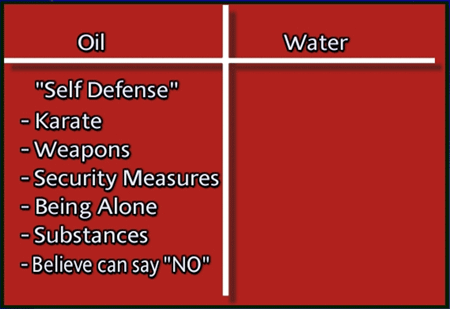
© 2005 Ron J. Hammond, Ph.D.
Women spend time, money, resources, and emotional energy being vigilant against a potential attack. The burden of protection falls mostly on them and their close friends and family. My students carry their keys so they can use them as weapons, carry pepper mace, take Karate, travel only with friends at night, and some even have a safety plan for their apartment. But, you have to know, there is no single preventative measure that can universally prevent rape. I interviewed a former FBI profiler, Greg Cooper. When I interviewed him he indicated that the FBI puts all the blame for the rape on the perpetrator, not the victim.
“Often times rape victims blame themselves, trying to figure out what exactly they did to cause the attack. From a law enforcement point of view, victims have no responsibility. There is nothing that the FBI can tell a woman to wear, to do, or to say that will decrease her likelihood of being attacked. The perpetrator bears all the blame and it's him that we focus on. (From documentary called “Oil and Water: The Truth About Rape” by Hammond available at Insight Media at http://www.insight-media.com/IMHome.asp).
Women know from their childhood that certain men can be dangerous and that they have to become diligent in protection themselves. In Figure 3 you see the clear and simple truth that rape is never a victim's fault (remember that sex has consent rape does not). There is not one case, ever where a rape victim is at fault. I've heard many argue with me on that point. They say, “what if she dressed in sexy clothes, went into the bar looking for some action, invited him up to her place, agreed to go on the date…” This type of thinking seeks to shake the oil and water together by erasing that line that separates them (oil and water don't mix, no matter how hard you shake the Italian dressing, it eventually separates back into oil and water). If we ask them to explain the details, then carelessly say something like, “why'd you go on a date with him anyway?” then we've just blamed the victim.
Figure 4 shows both the ideas in the same diagram. It's like the woman standing on the sidewalk and a man drives up on the sidewalk and runs her over. And an eye witness rushes to her aid and says, “Why were you standing on that sidewalk when you knew a truck could run you over? Were you trying to get attacked?”
Figure 3. The Water Side of The Oil and Water Paradigm
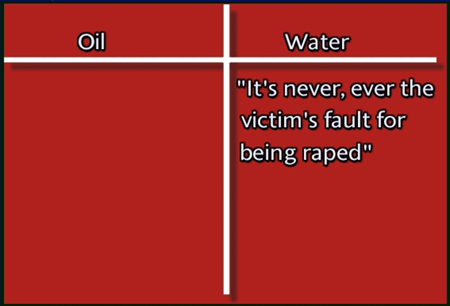
© 2005 Ron J. Hammond, Ph.D.
Figure 4. The Complete Oil and Water Paradigm
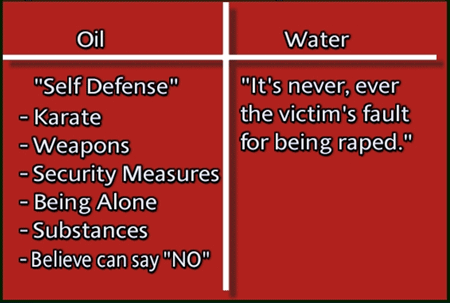
© 2005 Ron J. Hammond, Ph.D.
Think about what a rape victim has been through: bruises, cuts, gun & stab wounds, STDs, and pregnancies, internal injuries, chronic pain, persistent headaches, facial pain, sleep disorders, depression, PTSD, attachment problems, trust challenges, and flashbacks, anxiety, panic attacks, difficulty turning to closest support system (family, Friends, others). On www.rainn.org one rape survivor compared her attack to the September 11, 2001 terrorist attacks on the U.S. She explained that just like we often refer to the pre 9-11 era of this country, she refers to the pre-rape era of her life. “The party was over, my life utterly and permanently altered. In an instant I fell from grace, moving through feelings of invincibility to vulnerability.”
Not only do rapists hurt their victims, they often blame them verbally before they leave. This makes recovery even more difficult since most rape victims already blame themselves (see Ullman et al 2007 about the construct of self-blame and a model for assisting survivors in their recovery at http://web.ebscohost.com/ehost/pdf?vid=4&hid=12&sid=fc79a530-e9be-4ea8-b7fe-2d8685c8e3fc%40sessionmgr2 and in Murnen, et al. 1989 a study of college student established that most victims blamed themselves at http://web.ebscohost.com/ehost/pdf?vid=3&hid=106&sid=ff3c3bae-508b-4591-92ea-da2718858e21%40sessionmgr108 ).
Yes, it is true that most victims erase the line and blame themselves. “I should have…” is the most common lamentation. Hind sight gets confounded by grief and recovery. Yet, the last thing a rape victim needs is for you or anyone else in their support network to add to that grief by adding your intentional or unintentional blame. Keep oil and water apart. Defense attorneys often blame victims in the courtroom, media reports often imply or convey to blame to victims, and since rape victim's family and friends grieve too, they often blame self and the victims. You wouldn't slap a mugging victim for walking down the street alone. They've already been through enough. But, sometimes we believe that only good things happen to good people (Google “Just World Syndrome” for more insight to this myth). Violence happens to both morally good and bad people. It always has.
Helping Survivors To Avoid Blaming Themselves
Consider the comments made by two rape victims I personally interviewed (their names have been changed to protect their privacy). Nella had been raped in Colorado five years prior to our interview. The rapist trapped her and assaulted her over the course of three hours. Nella escaped and ran to get help from a friend. They called the police. The police put out an APB on the assailant's car and arrested him within the hour while he casually shopped for groceries in the local supermarket.
Nella told me that during the trial her attacker and his attorney turned the entire attack back against her.
“I sat stunned on the witness stand,” Nella explained. “Trying to figure out why I had to defend myself when I was the one who was so brutally attacked.” “I feel peace right now, but I live in constant fear that when he gets out, he'll somehow find me. Any way, he threatened my life while he attacked me, saying if I went to police he'd find me and kill me.” Nella explained through tear filled eyes. “I went to police anyway.”
Nella, like many other rape victims was emotionally victimized again during the trial. Nella's attacker was sent to prison and is already out on parole.
Jana's assailant was a coworker. He asked her out to dinner and attacked her in a secluded area near the restaurant. Afterwards, he showed no remorse, no guilt, not even an acknowledgment that he'd just done something terrible to her.
“He was such a nice man to me until we were alone.” Jana reported. “Then his countenance change. I saw evil in his eyes, but couldn't get away because he had planned the entire thing in advance.” Jana shook her head as she gently held the locket hanging on the chain around her neck. “This is a picture of my son.” She opened the locket. “He was the only good thing that came from the whole experience.”
Jana reported the rape to police. The rapist served time in jail and was under suspicion for other rapes in the area but nothing ever came of that. The rapist is out of prison now. Jana moved and tries to move on with her life, much like the countless other survivors throughout the state and country are forced to do.
In summary, on the personal level you can be a great asset to a survivor of rape. You might find yourself someday on a jury where other jurors blame her for not protecting herself. Look at Figure 5 and explain to them why the perpetrator is at fault.
Figure 5. Don't Mix the Oil and Water

© 2005 Ron J. Hammond, Ph.D.
Larger Social Explanations
At the larger social level rape can be understood through scientific studies, analysis of crime data, and interviews with rapists. We can understand trends about rapists and why they do what they do. We can also understand national social facts that can indicate how best to handle the problem from every level of social intervention. What are some of the possible explanations for high rape rates in the United States? A few trends emerge from my studies:
- An increase in rape prevention programs and rape crisis centers so that unlike in the past where a rape victim had a very difficult time in reporting rape, we now have a structure in place where victims can go for assistance. This may indicate that rape happened more in the past, but was reported less because of the absence of a legitimate place to go report it and get help.
- An increase in substance use among perpetrators and victims which is highly correlated with decreased inhibitions by men who might not otherwise act violently toward women.
- 1960s, 1970's, and 1980's shift from abstinence to sexual promiscuity where men are more likely to feel entitled to whatever sexual desire they have. This may have also coincided with male value shifts in expectations of self, women, and sexual predation (see Figure 6 below).
Figure 6. Value Shift Among Males (Especially Among Rapists) Over the Last 35 Years
| Was | Is Now |
|---|---|
| Courtship | Conniving |
| Dating | Deception |
| Friendship-based interactions | Felonious interactions |
| Protectors of females | Perpetrators of females |
| Mating market | Mating manipulation |
| Manly assertion of role | Macho aggression |
| Social responsibility | Anti-social self-indulgence |
| Protect fellow tribe members | Consume fellow tribe members |
| More human (prosocial) | Less-than-human (anti-social) |
© 2005 Ron J. Hammond, Ph.D.
Many men in our day have abdicated the protector, nurturer, and community-minded roles common among men in the past. Rapists have specifically become scam artists where the confidence scam of establishing trust among women then violating that trust has become all too common. Many rapists report feeling victimized when they are arrested and held accountable (over 6 out of 10 US rapist are not held accountable in terms of prison or guilty verdicts). Let me restate this crucial fact, rapists are the core of the problem (See Figure 7).
Changed Values Among Men
Figure 7. Rapist Are the Core of the Problem
Thesis: Rapists are less than human…sub-human individuals.
- Rapists act in anti-social violent ways toward other society members both within and beyond their own tribes.
- Rapists ignore life-long consequences to victims in search of their own self-gratification.
- Rapists have the equivalent of a Ph.D. in self-denial about their violent acts and denial of harm to their victims.
- Rapists are dangerous to themselves and others, behaving as social and personal equilibrium disruptors.
- Rapists are self-indulged, narcissistic quality of life destroyers.
- Rapists are scam artists, deceivers, and thugs.
© 2005 Ron J. Hammond, Ph.D.
As mentioned before, I interviewed Greg M. Cooper, a former FBI profiler. To the FBI, rape is not about sex. It is about power, domination, anger, and the ability to control and destroy another person's life. A rapist expresses his need power, domination, and anger in a sexual way. I must say this confuses many students. They ask, “How can rape not be sexual if the vagina and penis and other sexual parts of the body are involved?” My answer follows the statement made by a Nun who was teaching a group of survivors. I can't remember her name, but her point makes clear sense.
“A man can use his hand with a number of different motivations. He could caress the hair of his loved one, massage a back, or simply hold another-motivated by love and concern. He could also strangle, beat, and otherwise inflict pain upon another. It's not that the hand is a body part exclusively designed for nurturance or violence-it's the motivation behind how the hand is used that makes the hand what it is.”
The same can be said about our body's sexual parts. In a mutually consenting relationship between people of legal age of consent, sexual parts of the body can be used out of a motivation of intimacy. For rapists the sexual parts are used out of power, domination, anger, and control.
Greg Cooper utilized a model with 4 types rapists based on their risk of harm to the victim and their level of confidence in their violence. A power-reassurance rapist is the most common type of rapist, he uses little to no violence, has a very weak sense of self and of lacking “manliness,” and rape is his outlet of power, domination, anger, and control (see Figure 8). This rapist is inadequate in general and rapes in a futile attempt to feel adequate. The power-assertive rapist has a very low self-concept, he attempts to reassure himself on his manhood, and uses very little force or violence. His deep-seated shame drives him to offend often and not feel long-term satisfaction from the assaults.
Figure 8. Four Types of Rapists
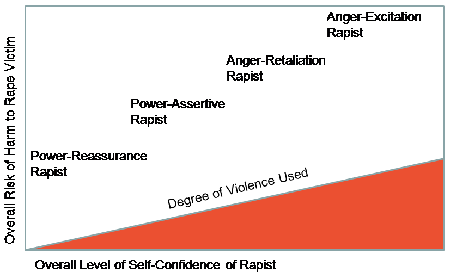
© 2005 Ron J. Hammond, Ph.D. (special Thanks to Greg M. Cooper, FBI, Retired)
The next two types of rapists are more dangerous. They tend to have a better self-image and will use violence. The Anger-Retaliatory Rapist has plenty of self-confidence (perhaps to the point of too much), he tends to demean, degrade, humiliate, and punish his victim for things she did not do (for example his bad day at work might be taken out on her), and he tends to be brutal, blitzing his victims so that they offer little resistance. This rapist is making the victim pay for things gone badly in his own life.
The Anger-Excitation Rapist is the least common type, yet the most evil: he will torture, kidnap, and even kill his victim out of pleasure-seeking at the cost of another's pain, he is sadistic and predatory, and he uses his intelligence to plot and prey upon unsuspecting victims. Greg Cooper also referred to him as “evil” and “the dark side of humanity.”
How can a man ascribe to such low values toward another individual? I borrow my answer from a Ugandan born man who lived in South Africa for a decade. David Ssjeinja said, in our interview about the enormously high rape rates in South Africa, that:
“Real men don't rape. Raping is really against the character of a good man and all that is necessary for good behavior in a civilized world.”
Perhaps this will be the legacy of the first decade of the new millennium, where social reform programs focus on efforts to transform values of men toward a more respectful view of women. Such an organization can be found today online, http://www.mencanstoprape.org/ . Men Can Stop Rape is an organization that allies male youths to women in preventing rape and other acts of violence toward women. One hopes that some of society's potential rapists get exposure to such a program, experience a shift in values toward respecting women, and ultimately lower the incidence of rape in Utah and The United States.
Useful Internet Resources About Rape and Rape Prevention
www.fbi.gov/ucr/cius_02/html/web/offreported/02-nforciblerape04.html
www.Rainn.org
www.ojp.usdoj.gov/bjs/welcome.html
www.search.utah.gov/retina/public/suggest.do?title=Prevalence%2C+Incidence%2C+and+Consequences+of+Violen...&id=&links=%5BRAPE%5D&reference=http%3A%2%2Fhealth.utah.gov%2Fvipp%2Fpdf%2Fviolenceagainstwomensurvey.pdf
www.mencanstoprape.com
www.ojp.usdoj.gov/nij/pubs-sum/172837.htm
www.cdc.gov/ncipc/factsheets/ipvfacts.htm